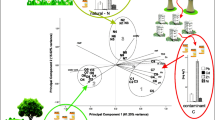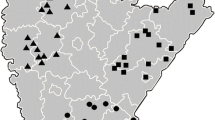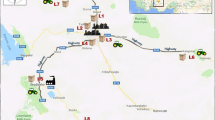Abstract
The concentrations of three representative heavy metals(cadmium, chromium and lead) were measured by atomic absorptionspectroscopy in honeybees and in apiary's products (honey,pollen, propolis, and wax). Samples were collected from fivedifferent sampling points: four from areas surrounding the cityof Rome, and the fifth in the city center which receives intensevehicular traffic. All apiaries employed for this study werespecifically constructed without any metal part in order toavoid the risk of contamination of the assayed materials.Sample collection was conducted over a 3-month period (6samplings for honey and pollen, 3 sampling for propolis and wax,2 samplings for honeybees, all of which were collected in duplicate). Experimental data revealed, in general,statistically significant differences between the backgroundlevels of heavy metals recorded from the reference sites and thelevels measured in the site located in the center of the city ofRome.These results indicate that honeybees and, to a lesser extent,some of their products (pollen, propolis, wax, but not honey),can be considered representative bioindicators of environmentalpollution.
Similar content being viewed by others
References
Biniecka M., Conti, M. E. and Campana, P.: 1995, 'Propolis (Bee Glue)-Pharmacological qualities and properties; microelements determination', in Proceedings of 10th JGWT Symposium, (ed.) Peking University Press, Beijing, Renmin University of China, Sept. 4–8 p. 507.
Bromenshenk, J. J., Carlson, S. R., Simpson, J. C. and Thomas, J. M.: 1985, 'Pollution monitoring of Puget Sound with honeybees', Science 227, 532–634
Celli, G., Porrini, C. and Tiraferri, S.: 1987, 'L'ape come insetto-test dei pesticidi', Inf Agrario, XLIII 38, 59–63.
Cesco, S., Barbattini, R. and Agabiti, M. F.: 1994, 'L'ape: insettot-test dell'onquinamento ambientale da cadmio e piombo? Esperienze di monitoraggio di Portogruaro (Venezia)', Apicoltura 9, 103–118.
Cimino, G., Ziino, M. and Panuccio, M. R.: 1984, 'Heavy metal pollution. Part X: impact of volcanic activity on Etnean honey', Environ. Technol. Lett. 5, 453–456.
Comune di Roma: 1997, Relazione sullo stato dell'ambiente a Roma, Maggioli Editore, pp. 1–309.
Conti, M. E., Saccares, S., Cubadda, F., Cavallina, R., Tenoglio, C. A. and Ciprotti, L.: 1998, 'Il miele nel Lazio: indagine sul contenuto in metalli in tracce e radionuclidi', Riv Sci Alim 2, 107–119.
Crane, E.: 1975, Honey: A Comprehensive Survey, William Heinemann in co-operation with International Bee Research Association, London.
Crane, E.: 1984; 'Bees, honey, and pollen as indicators of metals in the environment', Bee World 65(1), 47–49.
Cubadda, R., La Notte, E., Esti, M., Marconi, E., Panfili, G., Mancini, M. P. and Trivisonno M. C.: 1995, 'Studio dell'ambiente utilizzando l'ape come bioindicatore', in Rilevamento di contaminanti e valutazione della qualitá dell'ambiente attraverso indicatori biologici, Universitá degli Studi del Molise, Dipartimento S.T.A.A.M., Campobasso, 114 p.
Di Giacomo, F., Franco, M. A., Giaccio, M., Prota, R., Floris, I., Chessa, M. and Sferlazzo, G.: 1996, 'Valutazioni statistische multivariate sul contenuto di metalli in mieli prodotti in prossimitá di fonti di inquinamento', Riv. Merceol. 35, IV, 295–310.
Franco, M. A., Chessa, M., Sferlazzo, G., Giaccio, M., Di Giacomo, F. and Prota, R.: 1997, 'Bee pollen as an indicator of environmental pollution by heavy metals', Riv. Merceol. 36, II, 67–78.
Franco, M. A., Chessa, M., Sferlazzo, G., Giaccio, M., Mi Giacomo, F., Prota, R. and Manca, G.: 1998, 'Beeswax as an indicator of environmental pollution by heavy metals', Riv. Merceol. 37(1), 3–11.
Franco, M. A., Di Giacomo, F., Prota, R., Satta, M., Sferlazzo, G. and Murmura, F.: 1996, 'Caratterizzazione del contenuto di metalli in mieli prodotti in prossimitá di fonti di inquinamento', in Proceedings of the XVII Congresso Nazionale di Merceologia, Lecce, Italy, 3–5 October 1996, pp. 781–786.
Istituto Zooprofilattico Sperimentale dell'Abruzzo e del Molise (IZS): 1991, Studio analitico dei mieli abruzzesi, Teramo, pp. 82.
Jamoussi, B., Zafaouf, M. and Ben Hassine, B.: 1995, 'Hydride generation/condensation system with an inductively coupled argon plasma polychromator for simultaneous determination of arsenic, antimony, selenium, lead, mercury and tin in honey', Intern. J. Environ. Anal. Chem. 61, 249–256.
Jones, K. C.: 1987, 'Honey as an indicator of heavy metal contamination', Water Air Soil Pollut. 33, 179–189.
Kump, P., Necemer, M. and Snajder, J.: 1996, 'Determination of trace elements in bee honey, pollen and tissue by total reflection and radioisotope X-ray fluorescence spectrometry', Spectrochimica Acta Part B 51, 499–507.
Leita, L., Muhlbachova, G., Cesco, S., Barbattini, R. and Mondini, C.: 1996, 'Investigation on the use of honeybees and honeybee products to assess heavy metals contamination', Environ. Monit. Assess. 43, 1–9.
Petrovic, Z. T., Mandic, M. L., Frgic, J. and Grgic, Z.: 1994, 'Ash and chromium levels of some types of honey', Z. Lebensm. Unters. Forsch. 198, 36–39.
Pinzauti, M., Frediani, D., Biondi, C., Belli, R., Panizzi, L., Cosimi, C. and Zummo, V.: 1991, 'Impiego delle api nel rilevamento dell'inquinamento ambientale', Analysis 8, 354–407.
Pratt, C. R. and Sikorski, R. S.: 1982, 'Lead content of wildflowers and honeybees (Apis mellifera) along a roadway: Possible contamination of a single food chain', Proceed. of the Pennsylvania Acad. of Sci. 56, 151–152.
Raes, H., Cornelis, R., Rzeznik, U.: 1992, 'Distribution, accumulation and depuration of administered lead in adult honeybees', Sci. Total Environ. 113, 269–279.
Stöcker, G.: 1980, in Schubert, R. and Schuh, J. (eds): Methodische und Theoretische Grundlagen der Bioindikation (Bioindikation 1), pp. 10–21. Martin-Luther-Universität, Halle (Saale), GDR.
Tong, S. S. C., Morse, R. A., Bache, C. A. and Lisk, D. J.: 1975, 'Elemental analysis of honey as an indicator of pollution', Arch. Environ. Health 30, 329–332.
Wallwork-Barber, M. K., Ferenbaugh, R. W. and Gladney, E. S.: 1982, 'The use of honeybees as monitors of environmental pollution', Am. Bee J. 122, 770–772.
Author information
Authors and Affiliations
Corresponding author
Rights and permissions
About this article
Cite this article
Conti, M.E., Botrè, F. Honeybees and Their Products as Potential Bioindicators of Heavy Metals Contamination. Environ Monit Assess 69, 267–282 (2001). https://doi.org/10.1023/A:1010719107006
Issue Date:
DOI: https://doi.org/10.1023/A:1010719107006




